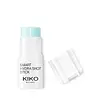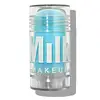What's inside
What's inside
 Key Ingredients
Key Ingredients

No key ingredients
 Benefits
Benefits

 Concerns
Concerns

 Ingredients Side-by-side
Ingredients Side-by-side

Water
Skin ConditioningSodium Stearate
CleansingButylene Glycol
HumectantPentylene Glycol
Skin ConditioningBis-PEG-18 Methyl Ether Dimethyl Silane
EmollientPEG-8
HumectantAlcohol Denat.
AntimicrobialDimethicone
EmollientPPG-26-Buteth-26
Skin ConditioningEthylhexylglycerin
Skin ConditioningPEG-40 Hydrogenated Castor Oil
EmulsifyingVp/Va Copolymer
Glycerin
HumectantSodium Polyacrylate
AbsorbentErythritol
HumectantBisabolol
MaskingTocopheryl Acetate
AntioxidantMenthyl Lactate
MaskingAlcohol
AntimicrobialPhenoxyethanol
PreservativeSodium Hyaluronate
HumectantLecithin
EmollientBHT
AntioxidantSodium Benzoate
MaskingPotassium Sorbate
PreservativeHomarine Hcl
Skin ConditioningCI 42090
Cosmetic ColorantWater, Sodium Stearate, Butylene Glycol, Pentylene Glycol, Bis-PEG-18 Methyl Ether Dimethyl Silane, PEG-8, Alcohol Denat., Dimethicone, PPG-26-Buteth-26, Ethylhexylglycerin, PEG-40 Hydrogenated Castor Oil, Vp/Va Copolymer, Glycerin, Sodium Polyacrylate, Erythritol, Bisabolol, Tocopheryl Acetate, Menthyl Lactate, Alcohol, Phenoxyethanol, Sodium Hyaluronate, Lecithin, BHT, Sodium Benzoate, Potassium Sorbate, Homarine Hcl, CI 42090
Water
Skin ConditioningPropanediol
SolventBis-PEG-18 Methyl Ether Dimethyl Silane
EmollientSodium Stearate
CleansingAloe Barbadensis Leaf Juice
Skin ConditioningKappaphycus Alvarezii Extract
Skin ConditioningMaris Aqua
HumectantCaffeine
Skin ConditioningGlycerin
HumectantStearic Acid
CleansingNylon-12
Sodium Sulfate
Sodium Chloride
MaskingCitric Acid
BufferingPotassium Sorbate
PreservativeSodium Benzoate
MaskingChlorphenesin
AntimicrobialPhenoxyethanol
PreservativeCI 42090
Cosmetic ColorantWater, Propanediol, Bis-PEG-18 Methyl Ether Dimethyl Silane, Sodium Stearate, Aloe Barbadensis Leaf Juice, Kappaphycus Alvarezii Extract, Maris Aqua, Caffeine, Glycerin, Stearic Acid, Nylon-12, Sodium Sulfate, Sodium Chloride, Citric Acid, Potassium Sorbate, Sodium Benzoate, Chlorphenesin, Phenoxyethanol, CI 42090
Ingredients Explained
These ingredients are found in both products.
Ingredients higher up in an ingredient list are typically present in a larger amount.
Bis-Peg-18 Methyl Ether Dimethyl Silane belongs to the siloxanes and silicones classes. It is synthetically created and has a waxy composition.
This ingredient is a humectant and emollient, meaning it helps hydrate the skin. Humectants draw moisture to your skin, while emollients prevent moisture from escaping.
Ci 42090 is a synthetic dye created from petroleum. It is used to give a bright blue color to cosmetics, medicine, and food.
Glycerin is already naturally found in your skin. It helps moisturize and protect your skin.
A study from 2016 found glycerin to be more effective as a humectant than AHAs and hyaluronic acid.
As a humectant, it helps the skin stay hydrated by pulling moisture to your skin. The low molecular weight of glycerin allows it to pull moisture into the deeper layers of your skin.
Hydrated skin improves your skin barrier; Your skin barrier helps protect against irritants and bacteria.
Glycerin has also been found to have antimicrobial and antiviral properties. Due to these properties, glycerin is often used in wound and burn treatments.
In cosmetics, glycerin is usually derived from plants such as soybean or palm. However, it can also be sourced from animals, such as tallow or animal fat.
This ingredient is organic, colorless, odorless, and non-toxic.
Glycerin is the name for this ingredient in American English. British English uses Glycerol/Glycerine.
Learn more about GlycerinPhenoxyethanol is a preservative that has germicide, antimicrobial, and aromatic properties. Studies show that phenoxyethanol can prevent microbial growth. By itself, it has a scent that is similar to that of a rose.
It's often used in formulations along with Caprylyl Glycol to preserve the shelf life of products.
Potassium Sorbate is a preservative used to prevent yeast and mold in products. It is commonly found in both cosmetic and food products.
This ingredient comes from potassium salt derived from sorbic acid. Sorbic acid is a natural antibiotic and effective against fungus.
Both potassium sorbate and sorbic acid can be found in baked goods, cheeses, dried meats, dried fruit, ice cream, pickles, wine, yogurt, and more.
You'll often find this ingredient used with other preservatives.
Learn more about Potassium SorbateSodium Benzoate is a preservative. It's used in both cosmetic and food products to inhibit the growth of mold and bacteria. It is typically produced synthetically.
Both the US FDA and EU Health Committee have approved the use of sodium benzoate. In the US, levels of 0.1% (of the total product) are allowed.
Sodium benzoate works as a preservative by inhibiting the growth of bacteria inside of cells. It prevents the cell from fermenting a type of sugar using an enzyme called phosphofructokinase.
It is the salt of benzoic acid. Foods containing sodium benzoate include soda, salad dressings, condiments, fruit juices, wines, and snack foods.
Studies for using ascorbic acid and sodium benzoate in cosmetics are lacking, especially in skincare routines with multiple steps.
We always recommend speaking with a professional, such as a dermatologist, if you have any concerns.
Learn more about Sodium BenzoateSodium stearate is the sodium salt of stearic acid.
The structure of sodium stearate makes it both a cleanser and emulsifier. As a cleanser, it helps dissolve dirt, oil, and other pollutants. As an emulsifier, it helps prevent ingredients from separating. This adds stability to the formula.
Water. It's the most common cosmetic ingredient of all. You'll usually see it at the top of ingredient lists, meaning that it makes up the largest part of the product.
So why is it so popular? Water most often acts as a solvent - this means that it helps dissolve other ingredients into the formulation.
You'll also recognize water as that liquid we all need to stay alive. If you see this, drink a glass of water. Stay hydrated!
Learn more about Water